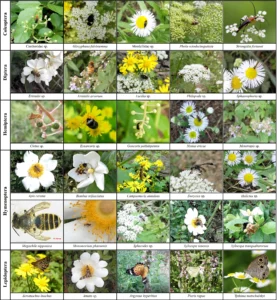New publication: don’t forget the pollinators in forest restoration!
We live in the century of restoration.
Governments around the world have committed to restoring 1 billion hectares of degraded land this century – greater than the total land area of China – in order to reverse the loss of biodiversity and mitigate climate change.
Billions of trees have already been planted on degraded lands over the past 20 years, through initiatives such as the UN Convention to Combat Desertification, the UN Decade on Ecosystem Restoration, the Bonn Challenge, the New York Declaration on Forests, Initiative 20×20 in Latin America, the African-led Great Green Wall initiative, AFR100, and most prominently China’s Three North Shelter Forest Program.
But does planting ‘more trees’ make better forests?
A new study published in Nature Ecology & Evolution by researchers at The University of Western Australia and CSIRO working with colleagues at Zhejiang University in China, suggests this is not always the case.

The common flower-visiting insects of the Thousand Island Lake, China. Photo credits: Peng Ren.
Project leader Professor Ping Ding and colleagues found the interior of dense even-aged secondary forests harbour a low diversity of flowering native plants and depauperate insect pollinator assemblages – in stark contrast to the complex patchiness of gaps and clearings found in natural forests, where higher light levels stimulate abundant floral resources that support diverse plant-pollinator networks.
In regenerating forests, PhD student and lead author Peng Ren observed that many insect pollinators actually preferred open sunny conditions created by forest edge disturbance, and he set out to challenge conventional wisdom that human-induced forest edges exacerbate the negative effects of forest loss on biodiversity. Ren tested the counter-intuitive hypothesis that anthropogenically-created forest edges might actually have positive effects for pollinators in regenerating forests.
In the Thousand Island Lake region of eastern China, Ren’s team recorded almost 20,000 pollination interactions between 313 insect species and 68 flowering plant species along edge and interior gradients of 41 regenerating forest islands and 16 mainland reference sites over 3 years. As expected, plant richness and floral resource availability declined with decreasing forest area at both interior and edge sites, but surprisingly edges maintained 10-fold higher pollinator abundance and richness regardless of area loss. Edge networks maintained high network robustness to extinction following area loss, while forest interior networks collapsed in small forest patches.

Generalized multilevel SEM showing the direct and indirect pathways through which forest fragmentation influences plant-pollinator community structure and network architecture.
From a conservation perspective, there is a strong argument for recognising the value of anthropogenic edges for plant-pollinator communities in small regenerating forest patches. In situations where there is little old-growth forest left, and a strong move toward reforestation (for erosion control, carbon offsetting or biodiversity conservation), co-author Professor Raphael Didham says that care is needed to avoid pollinator loss in the landscape because dense closed secondary forests do not have the right environmental conditions or floral resources for many pollinators. This does not mean that forest fragmentation or edge creation are ‘good’ for biodiversity, in a general sense, but in the absence of effective restoration strategies that promote heterogeneity of forest gap structure and diversity of floral resources for pollinators, then anthropogenic edges can have an unexpected beneficial role to play in network resilience, at least in the early decades of forest restoration.
Tree-planting initiatives need to diversify spatial planning to build better forests for pollinators.
For more on this study, check out the Nature News & Views opinion piece here, the Nature Ecology & Evolution blog post here, the UWA press release here, and the original article here.
Ren, P., Didham, R.K., Murphy, M.V., Zeng, D., Si, X., & Ding, P. (2023). Forest edges increase pollinator network robustness to extinction with declining area. Nature Ecology & Evolution. DOI: 10.1038/s41559-022-01973-y